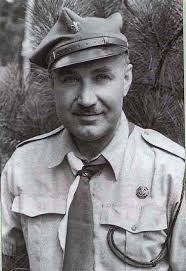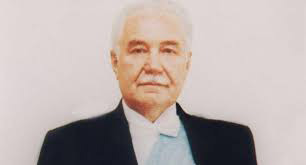
born: November 26, 1919, Białystok, Poland
died: April 10, 2010, Smoleńsk, Russia
buried: Warsaw – Świątynia Opatrzności Bożej
family: Father – Wacław, mother – Jadwiga nee Sawicka
Medals: Grand Cross of the Order of Pius (awarded by Pope John Paul II), honorary title of the Knight of the Grand Cross of the Order of St. Michael and St. George (awarded by Queen Elizabeth II), the Monte Cassino Cross, the Cross of Political Prisoners, the Franciscan Cross, the Home Army Cross, the Medal of the Jasna Góra Confederation
Fates before joining Anders Army: Ryszard Kaczorowski was born on November 26, 1919 in Białystok in a noble family. He was the younger son of Wacław and Jadwiga née Sawicki Kaczorowska. He grew up in a house at 7, Mazowiecka St. in Białystok. At the age of 14, he joined the scouting movement, where he belonged to the teams of Andrzej Małkowski, the founder of Polish scouting. Kaczorowski was active in scouting as an instructor, team leader and caretaker of summer camps. In 1934, he also began his education at the Białystok School of Economics. Shortly before the outbreak of World War II, he became the deputy commander of the Białystok Scouting Service, which was to play an auxiliary role in the event of war.
After the Red Army entered Białystok, he co-founded the underground structures of Szare Szeregi (Polish scouting conspiracy during WWII), including as a squadron and commander of the banners. He was a liaison between Szare Szeregi and the Commander of the Union of Armed Struggle (Związek Walki Zbrojnej). On July 17, 1940, he was arrested by the NKVD for his secret activities. Jailed in Białystok and Minsk, after a two-day trial on February 1, 1941, he was sentenced to death by a military court. After a hundred days of imprisonment on death row, on May 10, 1941, a court of the Soviet Union changed his sentence to 10 years in labor camps. He served his sentence in the Duskanja gold mine, known as the Death Valley, by Kolyma.
Military history in Polish 2 Corps: Released from the camp after the entry into force of the Sikorski-Majski pact, in March 1942 he joined the ranks of the Polish Army created in the USSR by General Władysław Anders and evacuated with it to Palestine. As a soldier of the 2nd Corps, he served in the Communication Battalion of the 3rd Carpathian Rifle Division. Together with the Corps, he fought in the Italian campaign, during the Battle of Monte Cassino as the commander of the communications center of the 2nd Carpathian Rifle Brigade.

Post-War: After the end of the war, Ryszard Kaczorowski remained in exile in Great Britain, where he completed his interrupted education. In 1947, he graduated from the Secondary School of the 3rd Carpathian Rifle Division in England, then he studied at the School of Foreign Trade, and then worked as an accountant for many years until his retirement in 1986. In 1952 he married Karolina Mariampolska, also repressed by the Soviets during WWII, with whom they had two daughters.
Remaining faithful to youthful ideals, Ryszard Kaczorowski joined the émigré activities of the Polish Scouting Association, first as the head of scouts in 1955-67, then as the chairman of the Polish Scouting Association outside the country in 1967-88. He was also the commander of the Polish representation at the International Jubilee Jamboree in 1957 and the commander of the World Scouting Rally at Monte Cassino in 1969 and in Belgium in 1982.
Ryszard Kaczorowski also participated in the political activities of Polish emigrants, incl. on the forum of the parliament in exile called the National Council. In 1986, in the government of Edward Szczepanik, he became the minister for national affairs. In January 1988, President-in-Exile Kazimierz Sabbat, in accordance with Articles 13 and 24 of the Constitution of the Republic of Poland of April 23, 1935, appointed him “the successor of the president in the event of his office being vacant before the peace was concluded”.
Ryszard Kaczorowski was also extremely active in the social life of emigration as a member of the Main Board of the Association of Polish Combatants (Stowarzyszenie Polskich Kombatantów), the Board of the Polish Union, the Council of the Polish Social and Cultural Center, the Council of Polska Macierz Szkolna, the Council of the Institute of Polish Catholic Action and the Coordination Council of the Polish Free World Association.
Ryszard Kaczorowski became the President in Exile after the sudden death of Kazimierz Sabbat, who held this office. On July 19, 1989, he was sworn in. He held this position for a year and a half. At that time, Poland saw significant changes to the political and economic system – Poland was slowly regaining its sovereignty. The expression of this situation was, among others, first democratic presidential election. On December 22, 1990, during a ceremony at the Royal Castle in Warsaw, accompanied by the delegate of the government-in-exile to Germany, Wincenty Broniwój-Orliński, Kaczorowski handed over the insignia of Polish national power, including of the Order of the White Eagle, the President Lech Wałęsa, elected in first free presidential elections after World War II, thus resigning his office.
After resigning from office, Ryszard Kaczorowski – although he did not return permanently to Poland – was still active in the public and social sphere. He continued to devote himself to social activities abroad, but now also in Poland. He is an doctor honoris causa of five universities: the University of Wrocław (1991), the Medical Academy in Białystok (1992), the University of Białystok (1998), the University of Opole (1998) and the Cardinal Stefan Wyszyński University in Warsaw (2008).
He died tragically in the plane crash of the presidential delegation near Smolensk, flying to celebrate the 70th anniversary of the Katyn Massacre. He was buried in the Crypt of the Great Poles of the Temple of Divine Providence in Warsaw. He is the patron of numerous schools, institutions and streets in Poland.
author: Aneta Hoffmann, Warsaw, Poland







